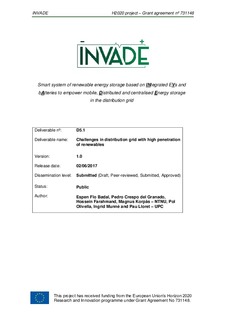| dc.description.abstract | The growing share of variable generation in Europe is increasing the need for flexibility in the electricity system. Flexibility on the demand side could be used by market players to optimise their portfolio as well as by system operators for balancing and constraints management purposes.
This document gives an overview of the main grid challenges caused by distributed generation, and how flexibility services from stationary and mobile batteries can be utilized to revile such problems. In this context, we have reviewed official documents and the literature of power systems to address the problems caused by distributed energy resources (DER) and the solutions proposed to solve these issues. The increasing diffusion of DERs in the distribution networks can change power flows, which eventually leads to operational issues, i.e., odd voltage profiles, overloaded components, decreased short circuit power and incorrect operation of protection systems. Therefore, from the DSO perspective, it is extremely important to estimate the available capacity of electrical networks or the so-called distribution grid hosting capacity.
Moreover, literatures have been extensively reviewed for standard definitions on flexibility. Flexibility in the power system has been a popular topic in recent years, but its definition and terminology use varies among authors, which can make it unclear what the term represents. This document provides some definitions and categorizations that provide a foundation for further work in the INVADE project.
Furthermore, the services for the distribution grid is discussed in relation to the other uses of the batteries (such as transmission system operator (TSO) support and balancing responsible party (BRP) support) and limitations of use (e.g. due to locational uncertainty of electrical vehicles (EVs) and driver range requirements). In this respect, the services that are most relevant for the INVADE-project are identified.
The document is closely related to “D4.1 INVADE Concept Design” which goes more in detail on the flexibility operator concept and defines which grid and power system services that should be emphasized in the further project work. This deliverable lays down a theoretical foundation and standard definition for necessary terminologies that can be used for remaining tasks in WP5, and can be applicable in both WP4 and WP8 as well as for pilot sites. | nb_NO |
